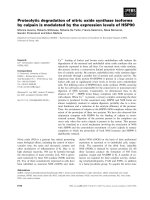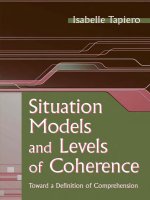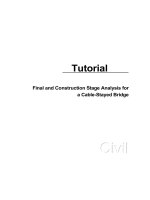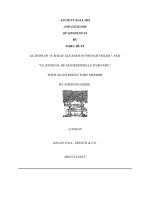SITUATION MODELS AND LEVELS OF COHERENCE: Toward a Definition of Comprehension potx
Bạn đang xem bản rút gọn của tài liệu. Xem và tải ngay bản đầy đủ của tài liệu tại đây (1.46 MB, 252 trang )
SITUATION MODELS AND LEVELS
OF COHERENCE
Toward a Definition of Comprehension
SITUATION MODELS AND LEVELS
OF COHERENCE
Toward a Definition of Comprehension
Isabelle Tapiero
University of Lyon
University of Lyon II
LAWRENCE ERLBAUM ASSOCIATES, PUBLISHERS
2007 Mahwah, New Jersey London
Lawrence Erlbaum Associates
Taylor & Francis Group
270 Madison Avenue
New York, NY 10016
Lawrence Erlbaum Associates
Taylor & Francis Group
2 Park Square
Milton Park, Abingdon
Oxon OX14 4RN
© 2007 by Taylor & Francis Group, LLC
Lawrence Erlbaum Associates is an imprint of Taylor & Francis Group, an Informa business
Printed in the United States of America on acid-free paper
10 9 8 7 6 5 4 3 2 1
International Standard Book Number-13: 978-0-8058-5550-0 (Hardcover)
No part of this book may be reprinted, reproduced, transmitted, or utilized in any form by any electronic,
mechanical, or other means, now known or hereafter invented, including photocopying, microfilming,
and recording, or in any information storage or retrieval system, without written permission from the
publishers.
Trademark Notice: Product or corporate names may be trademarks or registered trademarks, and are
used only for identification and explanation without intent to infringe.
Library of Congress Cataloging-in-Publication Data
Tapiero, Isabelle.
Situation models and levels of coherence : toward a definition of comprehension /
Isabelle Tapiero, Walter Kintsch.
p. cm.
ISBN 0-8058-5550-5 (cloth : alk. paper)
1. Comprehension. I. Kintsch, Walter, 1932- II. Title.
BF325.T37 2007 2006101919
Visit the Taylor & Francis Web site at
Cover design by Tomai Maridou.
To my mother
To the memory of my father
Contents in Brief
Foreword xv
Walter Kintsch
Preface xxi
PART I: TEXT COMPREHENSION: WHAT KIND
OF MENTAL REPRESENTATION DOES THE READER
BUILD? THE INTERNAL “OBJECTS” OF SITUATION
MODELS
1
1 Theoretical and Empirical Evidence for Two Main
Levels of Representation: Referential and Causal
Coherence
3
2 Situation Models as Integrated Representations:
What Kind of Model Does the Reader Build?
33
PART II: WHAT COGNITIVE MECHANISMS
ARE INVOLVED IN THE ELABORATION
OF A SITUATION MODEL?
55
3 Current Theories of Comprehension: The Main
Processes Involved in Mental-Representation Building
by the Reader
57
vii
4 Current Theories of Text Comprehension:
What About Coherence?
85
PART III: CONTRIBUTION OF READERS’
KNOWLEDGE IN THE ESTABLISHMENT
OF GLOBAL COHERENCE
115
5 Establishing Global Coherence: An Account of Readers’
Naive Theories of Causality
119
6 The Reader’s Mental Representation: Search
for Coherence or Passive Resonance?
137
PART IV: CONTRIBUTION OF THE READER’S
KNOWLEDGE AND THE MULTIDIMENSIONAL
ASPECT OF SITUATION MODELS: IMPORTANCE
OF CAUSALITY AND EMOTION
149
7 Causal Inferences in the Reading Comprehension
Process
151
8 Emotion and Text Comprehension 169
9 Are Some Dimensions More Crucial Than Others? 183
10 Toward a Definition of Comprehension 189
References 199
Author Index 215
Subject Index 221
viii CONTENTS IN BRIEF
Contents
Foreword xv
Walter Kintsch
Preface xxi
PART I: TEXT COMPREHENSION: WHAT KIND
OF MENTAL REPRESENTATION DOES THE READER
BUILD? THE INTERNAL “OBJECTS” OF SITUATION
MODELS
1
1 Theoretical and Empirical Evidence for Two Main
Levels of Representation: Referential and Causal
Coherence
3
1.1. The Semantic Level of Representation
(Kintsch & van Dijk, 1978) 3
1.1.1. Microstructure and Microprocessing 3
1.1.2. Macrostructure, Macroprocessing, and Importance
of Information 4
1.2. The Situational Level 6
1.2.1. Relationship Between Textual Information
and the Reader’s Knowledge 6
1.2.2. Need for This Level of Representation 7
ix
1.3. Prior Knowledge in Discourse Comprehension: From
Readers’ Expectations to Data-Driven Processing 8
1.3.1. First Generation of Cognitive Research in Reading
Comprehension. Meaning is “In The Head”:
The Concept of Schema 11
1.3.2. The Emergence of Meaning: “Fluctuation” Between
Bottom-Up and Top-Down Processes 14
1.3.2.1. Second Generation of Research on Text
Understanding: The Construction-Integration
Model (Kintsch, 1988, 1998) 14
1.3.2.2. The Third Generation of Research: The
Landscape Model (van den Broek, Risden,
Fletcher, & Thurlow, 1996) 26
2 Situation Models as Integrated Representations:
What Kind of Model Does the Reader Build?
33
2.1. The Internal “Objects” of Situation Models 34
2.1.1. The Predicate-Argument Schema
(Kinstch, 1988, 1998) 34
2.1.2. States, Events, and Actions Are the Core Elements
of Situation Models (Molinari & Tapiero, in press;
Tapiero, 1992; Zwaan, Langston, & Graesser,
1995) 40
2.1.3. Situation Models Result in an Automatic Mapping
Between Linguistic Input and an Activated
Knowledge Structure Called the Scenario
(Sanford & Garrod, 1981) 42
2.1.4. Situation Models as Amodal Structures: From
Propositional Symbols to a More Analogical
Relation Between Symbols and Referents
(Gernsbacher, 1990; Johnson-Laird, 1983) 46
2.1.5. Situation Models as an Analogical Mapping
Between Symbols and Referents (Barsalou, 1993,
1999; Glenberg, 1997; Johnson-Laird, 1983;
Zwaan, 2004) 47
x CONTENTS
PART II: WHAT COGNITIVE MECHANISMS ARE
INVOLVED IN THE ELABORATION OF A SITUATION
MODEL?
55
3 Current Theories of Comprehension: The Main
Processes Involved in Mental-Representation Building
by the Reader
57
3.1. Meaning Construction, Selection, and Integration: From
Word Identification to Text Understanding (Kintsch
& Mross, 1985; Till, Mross, & Kintsch, 1988) 57
3.2. Building Foundations for Structures, Mapping, and
Shifting to a New Structure (Gernsbacher, 1990) 61
3.3. Retrieval and Updating Processes 63
3.3.1. Implicit and Explicit Focus: The Processes of
Foregrounding and Backgrounding Information
(Sanford & Garrod, 1981, 1998) 63
3.3.2. Updating Requires Fast Information Retrieval and
Efficient Integration of New Information (Ericsson
& Kintsch, 1995; Zwaan & Radvansky, 1998) 66
3.4. Matching New Textual Information and Updating:
The Online and Backward Hypotheses 68
3.4.1. Updating as an Online Process 69
3.4.2. Updating as a Backward Process 70
3.4.3. An Integrated View of the Updating Process 70
3.5. Conditions That Have to Be Met in Order for the
Updating Process to Occur 75
3.6. Conclusion: What Are the Main Processes Involved
in the Elaboration of a Situation Model and Are There
Some Fundamental Processes in That Construction? 82
4 Current Theories of Text Comprehension: What About
Coherence?
85
4.1. Coherence as a Dynamic Component of Comprehension:
An Integrated View (Gernsbacher, 1990; Kinstch, 1988;
1998) 86
CONTENTS xi
4.2. Construction, Updating, and Coherence: Situational
Continuity as a Cue for Coherence (Gernsbacher, 1990;
Zwaan, Langston, & Graesser, 1995; Zwaan,
Magliano, & Graesser, 1995) 91
4.3. Coherence and Relevance: Two Core Concepts for
Integrating Bottom-Up and Top-Down Approaches to the
Reading Comprehension Process (Myers & O’Brien,
1998; Sanford, & Garrod, 1981, 1998) 94
4.4. Conclusion: What Kinds of Relationships Exist Between
These Cognitive Processes and the Postulated “Internal
Objects of Situation Models? 112
PART III: CONTRIBUTION OF READERS’
KNOWLEDGE TO THE ESTABLISHMENT
OF GLOBAL COHERENCE
115
5 Establishing Global Coherence: An Account of Readers’
Naive Theories of Causality
119
5.1. Establishing Local and Global Coherence: The Main
Hypotheses 119
5.2. The Causal Network Model as Representative of Readers’
Naive Theories of Causality 123
6 The Reader’s Mental Representation: Search for
Coherence or Passive Resonance?
137
6.1. Establishing Global Coherence: Situation Models as
Retrieval Structures 140
PART IV: CONTRIBUTION OF THE READER’S
KNOWLEDGE AND THE MULTIDIMENSIONAL
ASPECT OF SITUATION MODELS: IMPORTANCE
OF CAUSALITY AND EMOTION
149
7 Causal Inferences in the Reading Comprehension
Process
151
7.1. The Causal Inference Maker Model (CIM Model,
van den Broek, 1990a) 152
xii CONTENTS
7.2. The Main Conditions for the Generation of Forward
Inferences: Importance of Contextual Constraints
and Time Course for This Generation 155
7.3. When an Emotional Context Constrains the Generation
of Predictive Causal Inferences 162
8 Emotion and Text Comprehension 169
8.1. Representation of Characters’ Emotional State
in Narratives: Activation of Emotional Inferences 170
8.1.1. Readers Represent the Protagonist’s Emotional
State in a Specific Way 171
8.1.2. Representing the Protagonist’s Emotional State:
A General Feeling 172
8.2. Activation of Emotional Knowledge: An Automatic
Process 175
8.3. Influence of Reader’s Emotions on Text Understanding:
Induction of Emotional States 176
8.4. Readers’ Emotions and Text Understanding: When
Emotions Pertain to the Text’s Semantic Characteristics
181
9 Are Some Dimensions More Crucial Than Others? 183
9.1. The Event-Indexing Model and its Principles (Zwaan,
Langston, & Graesser, 1995; Zwaan, Magliano,
& Graesser, 1995) 183
9.2. Further Considerations About Situational Dimensions:
Toward a Possible Extension of the Event-Indexing
Model (Zwaan, Langston, & Graesser, 1995; Zwaan,
Magliano, & Graesser, 1995; Zwaan, Radvansky,
Hilliard, & Curiel, 1998) 186
10 Toward a Definition of Comprehension 189
10.1. The Nature of Situation Models 189
10.2. The Main Cognitive Processes Involved
in Situation-Model Building 192
10.3. The Role of Readers’ Prior Knowledge and Task
Constraints in Situation-Model Building 194
CONTENTS xiii
10.4. The Various Constraints for a Coherent Situation
Model: An Integrated View of The Comprehension
Process 197
References 199
Author Index 215
Subject Index 221
xiv CONTENTS
Foreword
Walter Kintsch
University of Colorado in Boulder
Most of us spend a good part of our days either reading or writing, so it is
surprising that the psychological study of these processes is a relative late-
comer. The investigation of learning processes began with memorizing lists
of nonsense syllables and running rats down mazes, not with what we do
everyday—reading all kinds of things. The study of thinking started with
puzzles of various kinds, not with the kind of inferences that are made in
reading. The reason is, of course, obvious: Investigators were put off by the
daunting complexity of studying discourse comprehension. Historically,
such study hasbeenthedomainof linguists, rhetoricians,andliterary schol
-
ars who emphasized and reveled in theintricaciesoftheir field. High litera
-
ture and subtle issues of syntax were their topics of choice. The methods
that psychologists had developed for work in their discipline were ill suited
for the exacting demands of such topics.
There were, of course, a few adventurous exceptions, F.C.Bartlettabove
all, but for the most part, serious psychology stayed away from text and dis
-
course until well after the start of the cognitive revolution. A hallmark of
that movement in the 1950s and 1960s was an emphasis on the central role
of language in cognition. Young linguists as well as psychologists eagerly
devoured Chomsky’s seminal Syntactic Structure and Aspects (Chomsky,
1957), only to become quickly disappointed by the master’s determination
to limit the study of language to syntax. Sure, syntax was crucial and fasci
-
nating, but everywhere psychologists looked, they were confronted with
meaning.
xv
In the early 1970s, anumber of trends converged to give riseto the mod
-
ern field of text and discourse that is the subject of this book. Several psy
-
chologists working in the area of memory endeavored to extend the study
of memory from list learning paradigms to memory for sentences and
memory for text. Representatives of that trend are Frederiksen (1975), An
-
derson & Bower (1972), and Kintsch (1970; 1974). This work was strongly
influenced by linguistics, most importantly the case grammar of Fillmore
(1968), the propositional analyses of Bierwisch (1969), and the micro
-
structure–macrostructure distinction of van Dijk (1972). The importance of
that early work was that it demonstrated that one could study memory for
discourse within the methodological framework of experimental psychol
-
ogy. Of course, whatwas studied here was no longer high literaturebut sim
-
ple sentences and trivial stories.
A major trend in those early years was schema theory, which had origi
-
nally been developed by Bartlett (1932) and Selz (1922) but suffered ne
-
glect in the interveningyears.Schema theory became very influential in the
1970s—the form of verb-frames in Fillmore (1968), propositional schemas
in Kintsch (1974), and the scripts of Schank & Abelson (1977), as well as the
story grammars of Mandler & Johnson (1977).
Thus, by the mid-1970s, the text and discourse area had acquired a no-
tion of structure—the schema—that remains basic to this day. What was
missing was a notion of process. How does discourse comprehension relate
to the processes traditionally studied by psychologists: memory, learning,
and attention? That link was formed with the publication of Towards a Model
of Text Comprehension (Kintsch & van Dijk, 1978). We analyzed comprehen-
sion asareal-time, capacity-limited process, inaccordancewith currentpsy-
chological knowledge about attention and short- and long-term memory.
With structure and process in place, one crucial element of text compre
-
hension theory was still missing. That was the realization that although text
comprehension starts with words, its outcome is no longer a purely linguis
-
tic object but a mental model that involves both linguistic and nonlinguistic
levels of representation. Because the term mental model was being used in a
variety of different ways for different purposes, van Dijk and I coined the
term situation model for this purpose (van Dijk & Kintsch, 1983). As this book
amply demonstrates, the notionofa situation model in text comprehension
has proved to be highly productive. One effect it has had is to open the
doors to the consideration of nonlinguistic representations, embodied or
perceptual representations in addition to (or for some, instead of) ver
-
bal-propositional representations. It is interesting to speculate about why
nonverbal representations have been relatively neglected until recent
years. It was not for a lack of appreciation for their importance. The mental
imagery notion has been around in psychology for many years and had
found a vocal proponent in Paivio(1969). My guess is, rather, that it was the
xvi
FOREWORD
lack of a suitable notation for mental images that would allow their use in
computational models. Linguists have provided psychology with workable
notational schemasforwords and sentences—it is easytocountwords or de
-
scribe theirstructuralrelations. Not so forimagesat this point, withthecon
-
sequence that psychologists build many models for words and few for
images.
Situation Models and Levels of Coherence provides a survey of the work that
has been done on text and discourse in the last fewdecades by psychologists
and cognitive scientists. Specifically, it focuses on the research based on the
methodologies of experimental psychology and computational modeling.
It is not, however, a review in the strict sense, but rather an integration of
several decades of research and theorizing as seen by Professor Tapiero.
Thus, it is an original piece of work that goes beyond the research that it
summarizes. She presents research results from the literature, her own as
well as that of others, clearly and objectively, but at the same time imposes
her own view and perspective ontheissues discussed. What emerges is not a
disjointed literature review, but a fresh picture of an entire research area.
Text and discourse researchers will find her views stimulating and worth-
while; students and novices will be able to obtain from this book a coherent
overview that will enablethem to become active participants in thisexciting
field.
A description of the current status of a field implicitly contains predic-
tions for its future. What can one say about the development of text and dis-
course research 10 or 20 years from now, based on this volume? Its title,
Situation Models and Levels of Coherence, indicates where Professor Tapiero
thinks the field is going. The big issue, the issue that she has devoted her
own research to as well as this book, is to specify and elaborate the nature
and role of situation models in text comprehension. This has been the cen
-
tral theme in discourse research during the last decade, not only of
Tapiero’s researchbutofmuch of the field, but it isstillunfinishedbusiness.
There have been several exciting and promising new approaches in recent
years that receive deserved attention in this book, such as the nature and
role of nonsymbolic, perceptual representations in the formation of situa
-
tion models. Another emerging research area that Tapiero favors concerns
the role of emotion and self-reference in comprehension. Both of these re
-
search directions have attracted a great deal of attention in recent years and
are well represented in this book. It is not too much to hope for that the re
-
sults from these investigations will be incorporated into a comprehensive
theory of comprehension in the coming years.
Another development that can be expected for the near future is prog
-
ress in computational theories of comprehension processes. Extant theo
-
ries—including my own construction-integration model—are not strictly
formal, testable models. They are not as underspecified as purely verbal
FOREWORD xvii
theories but do not meet the standards of formal models. I do not want to
denounce such theories; I think they have been and still are enormously
useful in providing a frameworkfor understanding comprehension. Never
-
theless, more rigorous, complete models of comprehension processes that
satisfy strict standards of formal modeling are needed for the future
development of text and discourse research.
What has impeded the emergence of such models in our field? We first
should note that the lack of adequate formal theories characterizes all re
-
search areas in higher ordercognition—conceptformation, analogical rea
-
soning, decision making, and so on. Models in all of these areas suffer from
similar problems as models of discourse comprehension. I believe thereis a
common reason for these deficiencies. Higher order cognition is knowl
-
edge dependent. Onecannotbuild models ofhigherorder cognition unless
one is able to model how human knowledge is structured and how it is used.
Until quite recently, thisjusthas not been possible. Researcherswereforced
to use hand-coded examples ofknowledge structures as needed. That is the
way I have operated in simulations with the CI model; that is the way other
discourse researchers have operated in modeling knowledge use and struc-
ture building; that is the way researchers operate in simulating analogical
problem solving: Providethe model with knowledge as needed, in the right
form, and lo and behold, it works! Once again, I am not criticizing this prac-
tice, which is all theorists could do. I am just suggesting that it is time to be
more ambitious. Comprehension research cannot be restricted to the labo-
ratory in the same way many problems in experimental psychology can be.
We are always interested in discourse in general, and the reader’s whole
person, goals, emotion, knowledge, and experience necessarily enter into
the process. Tapiero describes this situation very well in these pages. One
can be confident that researchers will pick up this challenge and formulate
better computational models of the comprehension phenomena discussed
here, made possible by modern methods of knowledge representation. In
the field of discourse, as in other areas of higher order cognition, you can’t
start with toy models andthenscale up—we have no choice but to model the
whole human in all its complexity.
The reader ofthisbook,whether an experienced text researcher, novice,
or graduate student, will not only find a great deal of information about the
current state of text research in these pages, but a coherent framework that
will help to make sense of this rich area of research. In fact, this is not only a
book for the specialist: Anyone who needs reliable information about this
field canfindit here, sifted andordered by a reliableand creative author.
REFERENCES
Anderson, J. R., & Bower, G. H. (1972). Human Associative Memory. Washington, DC:
Winston.
xviii FOREWORD
Bartlett, F. C. (1932). Remembering. Cambridge: Cambridge University Press.
Bierwisch, M. (1969). On certain problems of semantic representation. Foundations
of Language, 5, 153–184.
Chomsky, N. (1957). Syntactic structures. The Hague: Mouton.
Fillmore, C. J. (1968). The case for case. In E. Black & R. T. Harms (Eds.), Universals
of linguistic theory. New York: Holt, Rinehart and Winston.
Frederiksen, C. H. (1975). Representing logical and semantic structure acquired
from discourse. Cognitive Psychology, 7, 371–458.
Kintsch, W. (1970). Models for free recall and recognition. In D. A. Norman (Ed.),
Models of human memory (pp. 333–374). New York: Academic Press.
Kintsch, W. (1974). The representation of meaning in memory. Hillsdale, NJ: Lawrence
Erlbaum Associates.
Kintsch, W., & van Dijk, T. A. (1978). Towards a model of text comprehension and
production. Psychological Review, 85, 363–394.
Mandler, J. M., & Johnson, N. S. (1977). Remembrance of things parsed: Story
structure and recall. Cognitive Psychology, 9, 111–151.
Paivio, A. (1969). Mental imagery in associative learning and memory. Psychological
Review, 76, 241–263.
Schank, R. C., & Abelson, R. P. (1977). Scripts, plans, goals, and understanding.
Hillsdale, NJ: Lawrence Erlbaum Associates.
Selz, O. (1922). Zur Psychologie des Denkens und Irrtums. [On the psychology of think-
ing and misconceptions]. Bonn: Cohen.
van Dijk, T. A. (1972). Some aspects of text grammars. The Hague: Mouton.
van Dijk, T. A., & Kintsch, W. (1983). Strategies of discourse comprehension. New York:
Academic Press.
FOREWORD
xix
Preface
Understanding a text requires building a mental representation that is co-
herent. This mental representation, commonly called a situation model (van
Dijk & Kintsch, 1983) or a mental model (Johnson-Laird, 1983), is the result
of an interaction between the reader’s prior knowledge and information in
the text. One of my goals is to define what objects or entities compose the
situational level of representation and what main processes are imple-
mented by the reader to understand a text. Different types of formal mod-
els have been used to represent meaning: frames (Minsky, 1975), schemas
(Schank & Abelson, 1977), propositions (Kintsch & van Dijk, 1978), scenar-
ios (Sanford & Garrod, 1981), and cognitive categories such as states,
events, and actions (François, 1991; Molinari & Tapiero, 2005; Trabasso &
van den Broek, 1985; Zwaan, Langston, & Graesser, 1995). All of these enti
-
ties have been proposed to define the internal structure of a reader’s situa
-
tion model. However, one possibility is to see the structure of the situation
model as amodal (Gernsbacher, 1990) or as a structure that is analogous to
that of the states of affairs it represents (Johnson-Laird, 1983). Another
possibility is to view it in terms of perceptual and motor representations
(Barsalou, 1993, 1999; Glenberg, 1997; Zwaan, 2004). No matter what rep
-
resentational format is adopted, the “internal structure” of a situation
model should be the result of thereader’s ability to perceivereal-world situ
-
ations. This gives a crucial role to the reader’s knowledge in the emergence
of meaning and text interpretation (see also Sanford & Garrod, 1998).
Situation models are usually defined as cognitive representations of the
events, actions, individuals, andgeneralsituation evoked in a text. Thisdef
-
inition not only implies being able to imagine individuals’properties or the
linguistic relations they have, but also to understand the relationships be
-
xxi
tween the facts described locally and globally in the text. In describing the
different structures and processes involved in text comprehension, I pres
-
ent several empirical findings to show that situation models can be ade
-
quately constructed from entities in different formats, with the sole
constraint that these entities be related “in a coherent way.” Coherence has
been shown to be a function of several dimensions that index the facts rep
-
resented in the situation model: space, causation, time, intentionality, and
protagonists (Zwaan, Langston, & Graesser, 1995). In this view, the reader
is assumed to monitor the multiple situational dimensions that participate
in the comprehension process. However, although numerous studies have
investigated each of these five dimensions separately, only a few have ac
-
counted for their interrelationships.Inline with this multidimensional view
of the mental representation of a text, and to extend our knowledge of the
contribution of situational dimensions to the situation model elaborated, I
focus on two dimensions, causality and emotion, as well as on the inferential
processes they trigger. It has been widely demonstrated that readers use
their “naive” theories aboutcausalityto understand a text andtoconstructa
coherent representationofwhat it says. Thereisthus no doubt thatcausality
is a “necessary” component of situation models. However, although emo-
tions are crucial in everyday life events andinteractwithcognitive activities,
they have been neglected in the past by researchers working on language
and text comprehension, not because of their lack of interest for this di-
mension, but certainly more because of the complexity of investigating
them. I argue that it is necessary to more precisely define how emotion is in-
volved in text comprehension,not only in itself, but also inrelation to other
situational dimensions (e.g., causality). The situation model of a text, then,
would give coherence to the relevant elements of the situation described
(i.e., the dimensions), and the format or nature of the entities that compose
the model would simply facilitate the establishment of this coherence to a
greater or lesser extent.
What kind ofmentalrepresentationdoes the reader build? How does the
reader establish coherence—or rather, levels of coherence? I assume that
the reader’s mental representation is composed of related entities, and that
only the relevance assigned by readers to define these relations allows for
the “correct” interpretation of the text, and leads to several “levels” of com
-
prehension or coherence. This is a dynamic view of reading. In this view,
the reader proceeding through the text “activates” and “retrieves” the “rel
-
evant” relations that constitute the framework of his or her representation.
This representation, modified and enriched through the processing of text
information, is a function of the reader’s prior knowledge and the task con
-
straints. At certain points in the processing, it reinforces some relations,
whereas at otherpoints, thoserelationsareput into the background but still
“present” (see Sanford & Garrod, 1981, 1998; van den Broek, Risden,
xxii
PREFACE
Fletcher, & Thurlow, 1996). This representation can thus be regarded as
the convergence of multiple sources of information, namely the reader’s
prior knowledge, textual information that is being processed, and episodic
information that is no longerinworkingmemory. Each new piece of incom
-
ing information is matched to previously processed information. The rep
-
resentation gradually is updated and enriched by those sources, and this
accounts for the richnessof the final representation. Retrieval cues(i.e., na
-
ture and relevance) are crucial at this point. The reader’s knowledge and
task requirements are what assign relevance to the structure to retrieve.
Although many studies have been conducted to gain an in-depth under
-
standing of the cognitive processes underlying the situational level (i.e., the
mental model or situation model), we are still “groping in the dark”whenit
comes to defining the internal components (or structure) of the situational
level. The main goal of the first part of this book is to present the internal
objects that emerge from the literature and that I think are fundamental for
defining the structure of the reader’s situation model.
In chapter 1, a description of the two main levels of representation (se-
mantic and situational), within a referential and causal approach (i.e., co-
herence), is followed by a presentation of three main theories of
comprehension: Schema Theory (Mandler & Johnson, 1977; Stein &
Glenn, 1979; Trabasso & Sperry, 1985), the Construction-Integration
Model (Kintsch, 1988, 1998), and the Landscape Model (van den Broek,
Risden, et al., 1996; vandenBroek, Young, & Tzeng, & Linderholm, 1999).
These three theories are specific examples of the three generations of cog-
nitive research that have arisen in the domain of text comprehension and
that have been described recently (see van den Broek & Gustafson, 1999;
van den Broek, Young, et al., 1999). Schema Theory exemplifies the first
generation of research. It focuses on the top-down influence of the reader’s
background knowledge for interpreting text (here, stories) and on two
main types of relations between the assumed representational units in
memory: referential and causal coherence. The Construction-Integration
Model and the Landscape Model attempt to define the construction and in
-
tegration of meaning by including the activation of different concept
sources (e.g., episodic or related to prior knowledge). Whereas the former
model relies mainly on the different processes that take place as the reader
processes a text and corresponds to the second generation of models, the
latter emphasizes the bidirectional relationsbetweenthe process of reading
itself (online representation) and the result of the reading process (offline
representation). This dynamic view of the comprehension process corre
-
sponds to the third generation of models.
Chapter 2, the core of the first part, is devoted to the main internal com
-
ponents of situation models described in the literature. To my knowledge,
these “internal objects” have never been clearly identified, and this chapter
PREFACE xxiii
is aimed at providing a comprehensive ideaoftheirnature.I discuss the fol
-
lowing topics in detail: the contribution of the propositional formalization
as a representational format for the units that compose the situation model
(Kintsch, 1988, 1998; Kintsch & van Dijk, 1978; van Dijk & Kintsch, 1983),
the assumption that propositions cannot capture meaning and are only the
product of a previous interpretation (Sanford & Garrod, 1998), the dis
-
course pointers and tokens (Glenberg & Langston, 1992; Sanford &
Garrod, 1981, 1988; Zwaan & Radvansky, 1998), and the concepts of states
and events (Molinari & Tapiero, in press; Zwaan, Langston, & Graesser,
1995), two crucial semantic categories that are embedded in temporocausal
or hierarchical relations. I also develop the idea that the format (i.e., struc
-
ture and relations) from which individuals elaborate their model guides
and governs the internal characteristics of the model built (Johnson-Laird,
1983) and that people may routinely activate perceptual representations
during language comprehension (Barsalou, 1993, 1999; Glenberg, 1997;
Zwaan, 2004). The structure of a situation model could therefore be seen as
amodal (Gernsbacher, 1990), with no particular weight to any given repre-
sentational format. The situation model would be built from structures and
substructures that interact with real-world situations in terms of the
coherence of the dimensions implied.
Regardless of the “structure” of the situation model postulated, several
cognitive mechanisms underlie the elaboration of the reader’s mental rep-
resentation. In the second part of this book, I describe the main processes
(i.e., automatic and strategic) involved in text reading and comprehension,
with an emphasis on the dynamic aspect of their occurrence (chapter 3).
Then, I focus on those mechanisms assumed to be involved in elaborating
and maintaining coherence in situation models (chapter 4), and I empha
-
size the importance of determining how top-down processes interact with
more bottom-up processes. I end this chapter by discussing how these cog
-
nitive mechanisms are tied to potential “internal objects.” This is the first
step in defining “what the reader needs for comprehension.”
My aim to define “comprehension” could not be complete without dis
-
cussing the contribution of the reader’s knowledge, episodic or general.
One way of deeply investigating the contribution of prior knowledge is to
focus on how readers establish coherence when they are engaged in a situa
-
tion of discourse comprehension, which inevitably leads to a discussion of
inferential processes. In Part III, I propose a description of the main theo
-
ries that focus on how coherence is established in comprehension, in an au
-
tomatic or strategic manner (chapter 5), by bringing to the fore the
relevance of the coherence assumption of Global Models (Garrod & San
-
ford, 1988; Glenberg & Langston, 1992; Graesser & Clark, 1985; Graesser,
Singer, & Trabasso, 1994). What does it mean to build a coherent situation
model? Are the different levels ofcoherenceafunctionof the level of repre
-
xxiv
PREFACE









